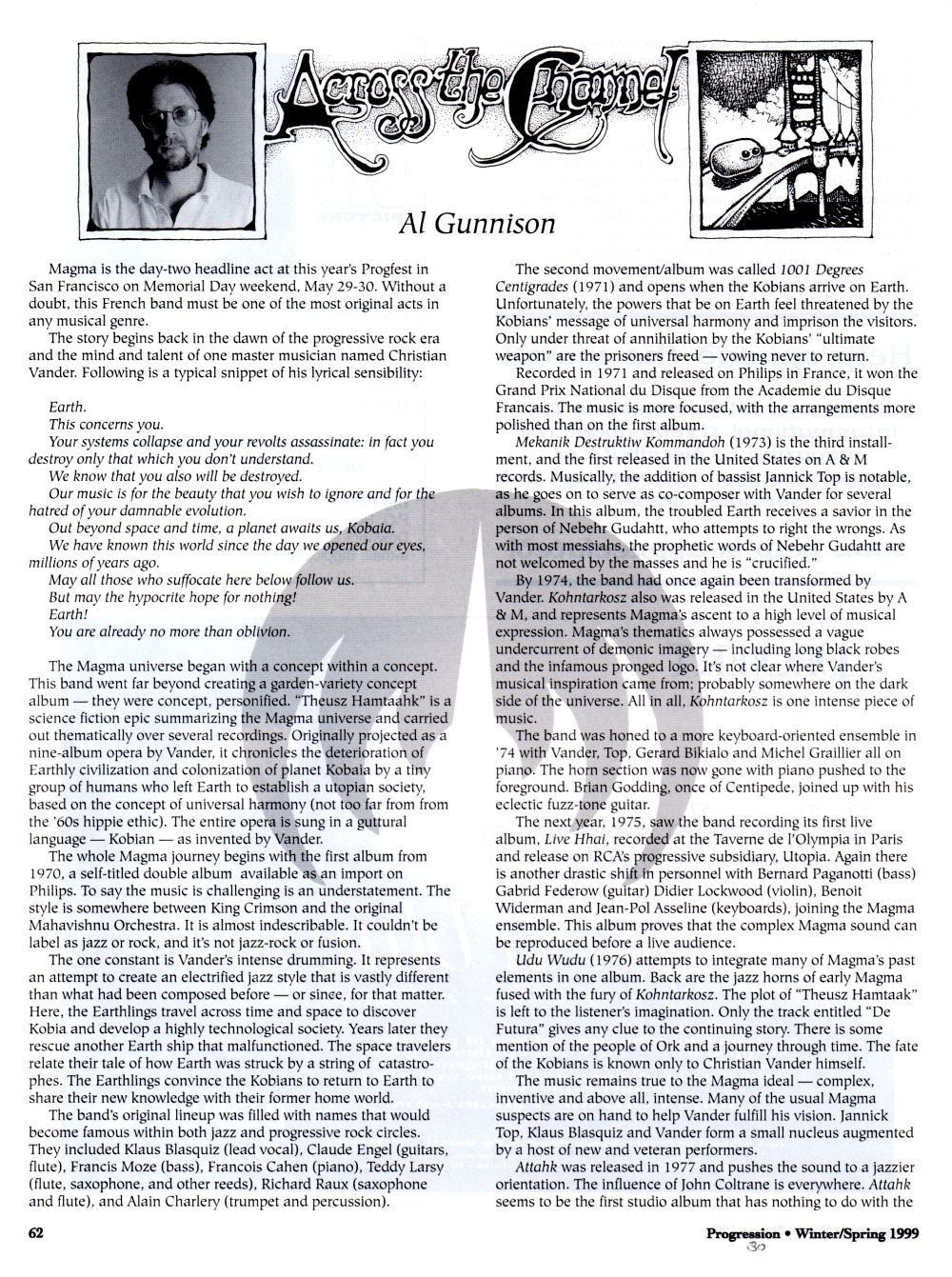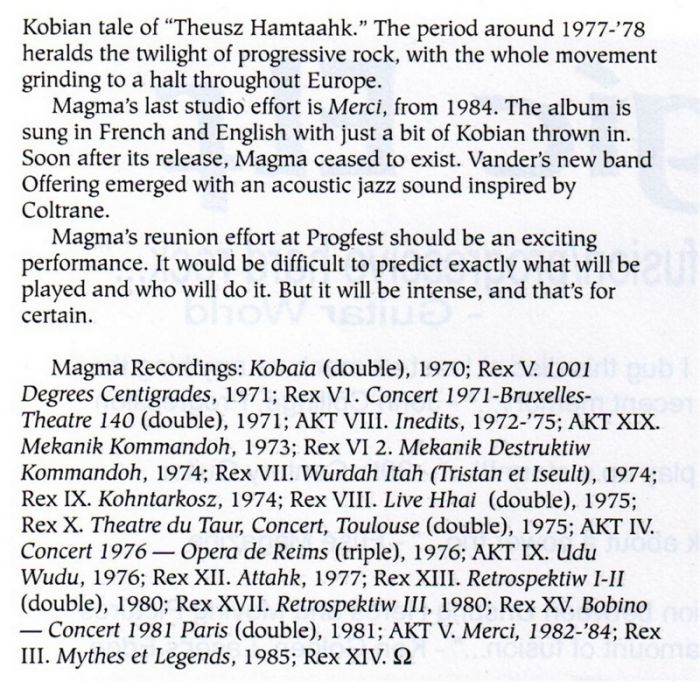Magma is the day-two headline act at this years Progfest in San Francisco on Memorial Day weekend, May 29-30. Without a doubt, this French band must be one of the most original acts in any musical genre.
The story begins back in the dawn of the progressive rock era and the mind and talent of one master musician named Christian Vander. Following is a typical snippet of his lyrical sensibility:
Earth.
This concerns you.
Your systems collapse and your revolts assassinate: in fact you destroy only
that which you don't understand.
We know that you also will be destroyed.
Our music is for the beauty that you wish to ignore and hatred of your damnable
evolution.
Out beyond space and time, a planet awaits u
We have known this world since the day we millions of years ago.
May all those who suffocate here below us
But may the hypocrite hope for nothing!
Earth!
You are already no more than oblivion
The Magma universe began within a concept
This band went far beyond creating a garden-variety concept album -- they were concept, personified. "Theusz Hamtaahk" is a science fiction epic summarizing the Magma universe and carried out thematically over several recordings. Originally projected as a nine-album opera by Vander, it chronicles the deterioration of Earthly civilization and colonization of planet Kobaia by a tiny group of humans who left Earth to establish a utopian society, based on the concept of universal harmony (not too far from the '60s hippie ethic). The entire opera is sung in a guttural language - Kobaian - as invented by Vander.
The whole Magma journey begins with the first album from 1970, a self-titled double album available as an import on Philips. To say the music is challenging is an understatement. The style is somewhere between King Crimson and the original Mahavishnu Orchestra. It is almost indescribable. It couldn't be label as jazz or rock, and it's not jazz-rock or fusion.
The one constant is Vander's intense drumming. It represents an attempt to create an electrified jazz style that is vastly different than what had been composed before - or since, for that matter. Here, the Earthlings travel across time and space to discover Kobaia and develop a highly technological society. Years later they rescue another Earth ship that malfunctioned. The space travelers relate their tale of how Earth was struck by a string of catastrophes. The Earthlings convince the Kobians to return to Earth to share their new knowledge with their former home world.
The band's original lineup was filled with names that would become famous within both jazz and progressive rock circles. They included Klaus Blasquiz (lead vocal), Claude Engel (guitars, flute), Francis Moze (bass), Francois Cahen (piano), Teddy Lasry (flute, saxophone, and other reeds), Richard Raux (saxophone and flute), and Alain Charlery (trumpet and percussion).
The second movement/album was called 1001 Degrees Centigrades (1971) and opens when the Kobians arrive on Earth. Unfortunately, the powers that be on Earth feel threatened by the Kobians' message of universal harmony and imprison the visitors. Only under threat of annihilation by the Kobians' "ultimate weapon" are the prisoners freed - vowing never to return.
Recorded in 1971 and released on Philips in France, it won the Grand Prix National du Disque from the Académie du Disque Français. The music is more focused, with the arrangements more polished than on the first album.
Mekanik Destruktiw Kommandoh (1973) is the third
installment, and the first released in the United States on A & M records.
Musically, the addition of bassist Jannick Top is notable, as he goes on to
serve as co-composer with Vander for several albums, the troubled Earth receives
a savior in the person of Neber Gudahtt, who attempts to right the wrongs.
As with most messiahs, the prophetic words of Nebehr Gudahtt are not welcomed
by the masses and he is "crucified."
By 1974 the band had once again been transformed by Vander. Kohntarkosz also
was released in the United States by A & M, and represent Magma's ascent
to a high level of musical expression. Magma's thematics always possessed
a vague undercurrent of demonic imagery - including long black robes and the
infamous pronged logo. It's not clear where Vander's musical inspiration came
from; probably somewhere on the dark side of the universe. All in all, Kohntarkosz
is one intense piece of music.
The band was honed to a more keyboard-oriented ensemble in '74 with Vander,
Top, Gerard Bikialo and Michel Graillier all on piano. The horn section was
now gone with piano pushed to the foreground. Brian Godding, once of Centipede,
joined up with his eclectic fuzz-tone guitar.
The next year, 1975, saw the band recording its first live album, Live Hhai, recorded at the Taverne de l'Olympia in Paris and release on RCA's progressive subsidiary, Utopia. Again there is another drastic shift in personnel with Bernard Paganotti (bass) Gabriel Federow (guitar) Didier Lockwood (violin), Benoît Widerman and Jean-Pol Asseline (keyboards), joining the Magma ensemble. This album proves that the complex Magma sound can be reproduced before a live audience.
Udu Wudu (1976) attempts to integrate many of Magma's past elements in one album. Back are the jazz horns of early Magma fused with the fury of Kohntarkosz. The plot of "Theusz Hamtaahk" is left to the listener's imagination. Only the track entitled "De Futura" gives any clue to the continuing story. There is some mention of the people of Ork and a journey through time. The fate of the Kobians is known only to Christian Vander himself.
The music remains true to the Magma ideal - complex, inventive and above all, intense. Many of the usual Magma suspects are on hand to help Vander fulfill his vision. Jannick Top, Klaus Blasquiz and Vander form a small nucleus augmented by a host of new and veteran performers.
Attahk was released in 1977 and pushes the sound to a jazzier orientation. The influence of John Coltrane is everywhere. Attahk seems to be the first studio album that has nothing to do with the Kobaian tale of "Theusz Hamtaahk." The period around 1977-78 heralds the twilight of progressive rock, with the whole movement grinding to a halt throughout Europe.
Magma's last studio effort is Merci, from 1984. The album is sung in French and English with just a bit of Kobaian thrown in. Soon after its release, Magma ceased to exist. Vander's new band Offering emerged with an acoustic jazz sound inspired by Coltrane.
Magma's reunion effort at Progfest should be an exciting performance. It would be difficult to predict exactly what will be played and who will do it. But it will be intense, and that's for certain.
Magma Recordings: Kobaia (double), 1970; Rex V. 1001 Degrees Centigrades, 1971; Rex Vl. Concert 1971 -Bruxelles- Theatre 140 (double), 1971; AKT VIII. Inedits, 1972-'75; AKT XIX. Mekanik Kommandoh, 1973; Rex VI 2. Mekanik Destruktiw Kommandoh, 1974; Rex VII. Wurdah Itah (Tristan et Iseult), 1974; Rex IX. Kohntarkosz, 1974; Rex VIII. Live Hhai (double), 1975; Rex X. Theatre du Taur, Concert, Toulouse (double), 1975; AKT IV. Concert 1976 - Opera de Reims (triple), 1976; AKT IX. Udu Wudu, 1976; Rex XII. Attahk, 1977; Rex XIII. Retrospektiw I-II (double), 1980; Rex XVII. Retrospektiw 111, 1980; Rex XV. Bobino - Concert 1981 Paris (double), 1981; AKT V. Merci, 1982-'84; Rex III. Mythes et Legends, 1985; Rex XIV.
Al
Gunnison
Progression, issue 30, Winter / Spring 1999
Zeuhl Merci : Daniel Schweizer

